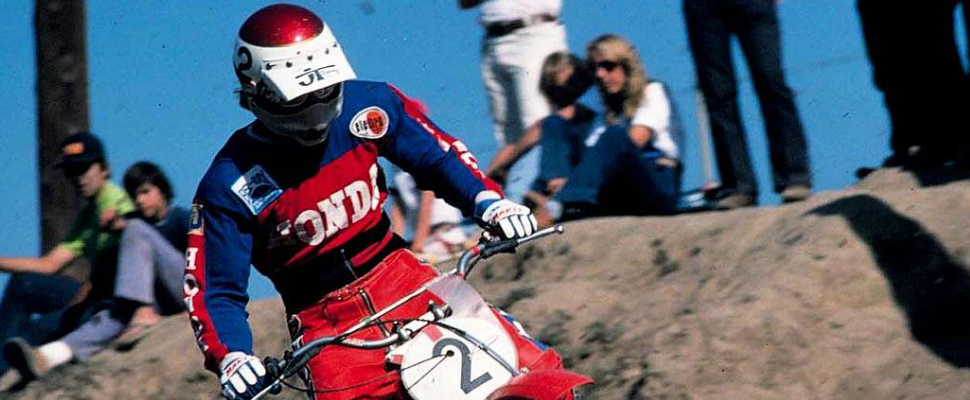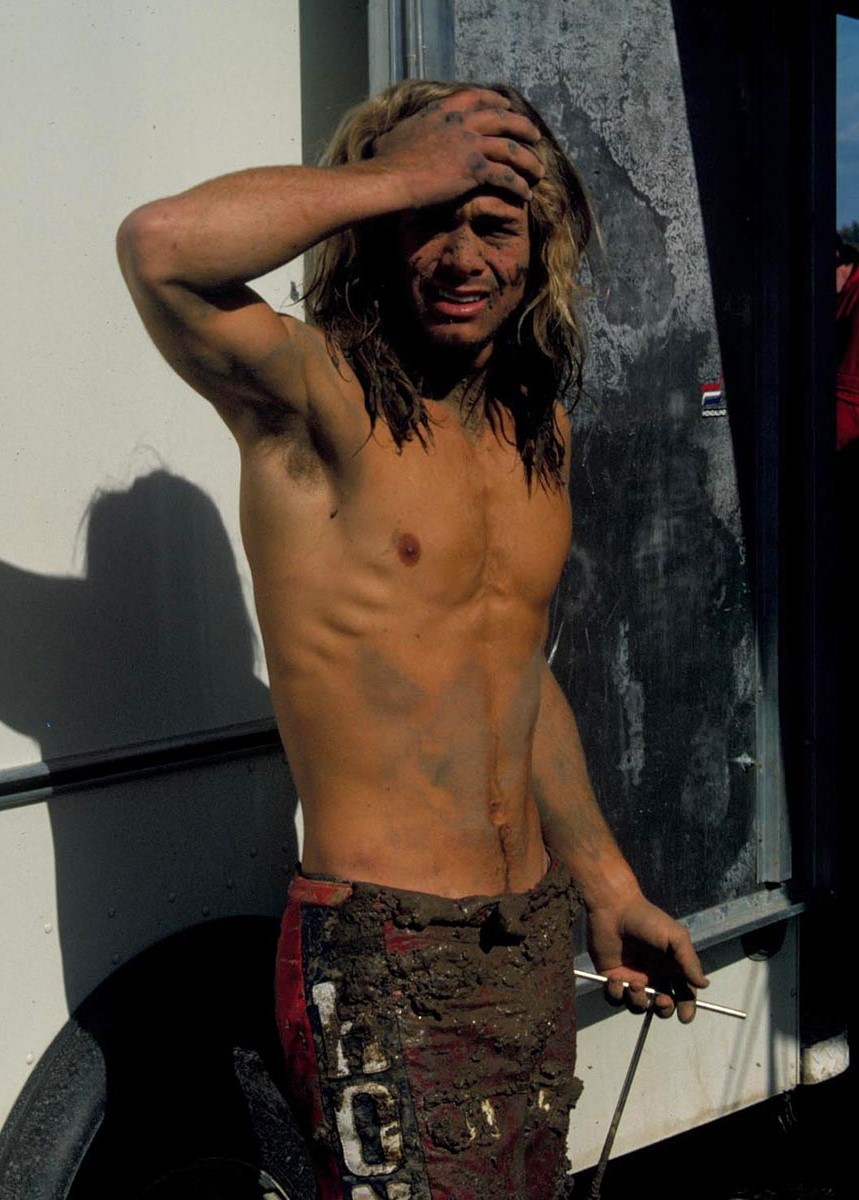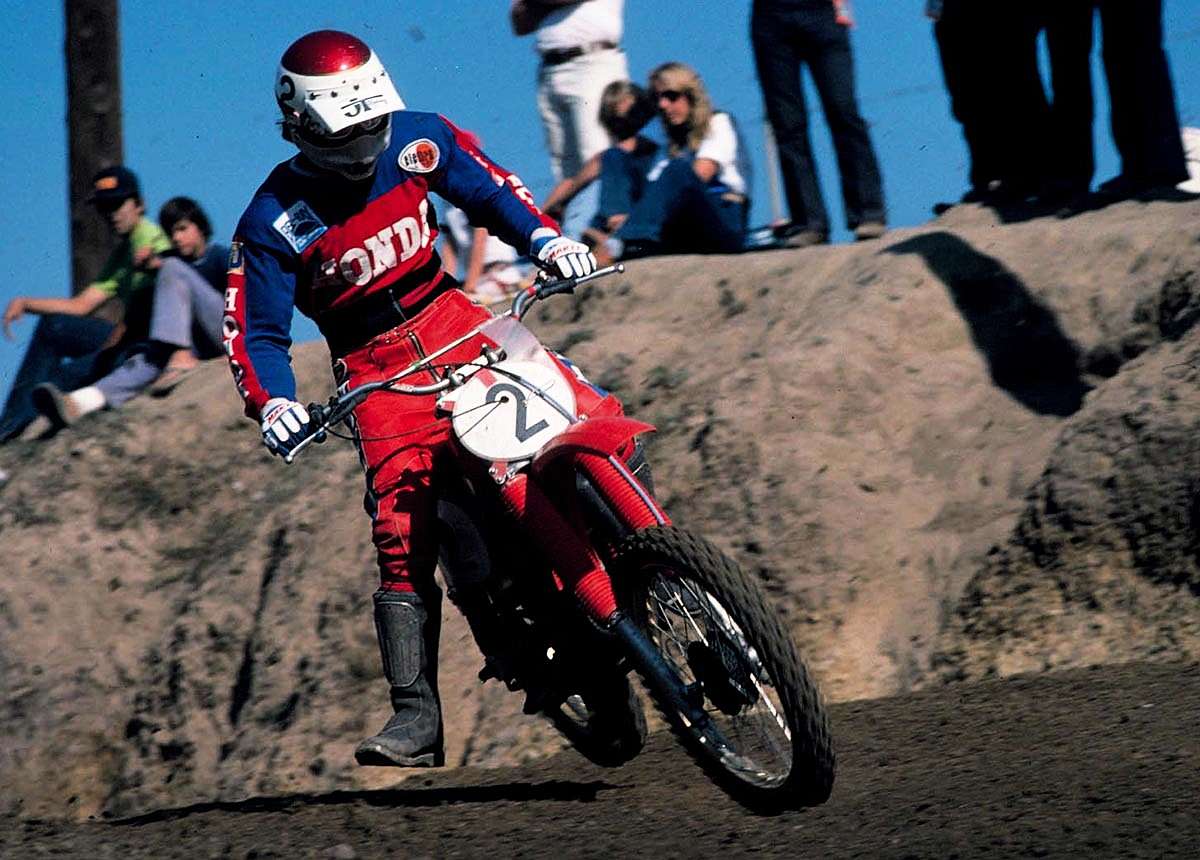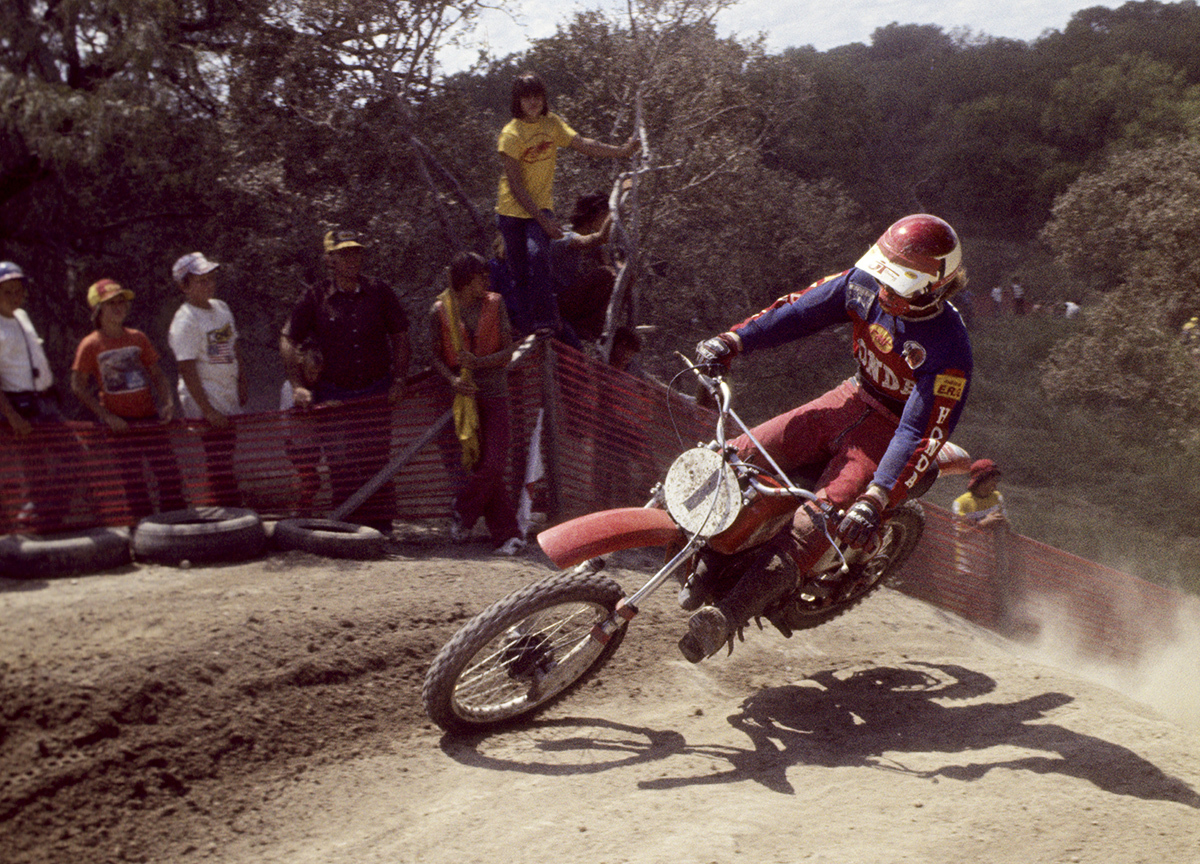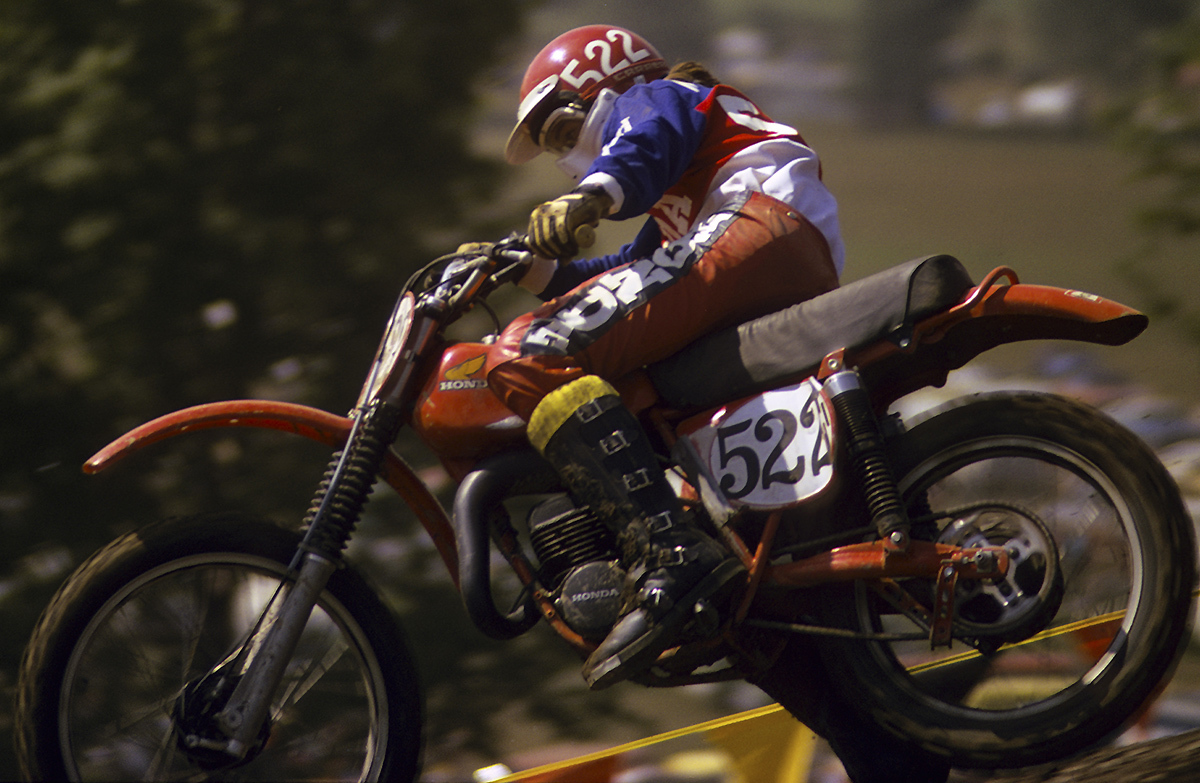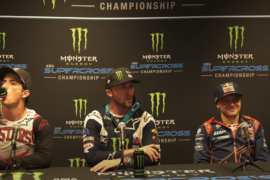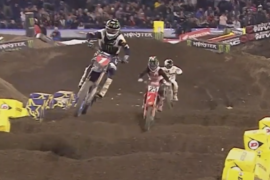Three time AMA Motocross Champion Marty Smith will always be a superstar in the eyes of anyone who follows the sport, and is older than 50 years old. From his long blonde hair, blue eyes, and surfer look, to his undeniable desire to win at all cost, Smith is one of the first American motocross heroes. Before him there was no real history, but in the 1970s, as American motocross started to grow, it was Smith who led from the front, and let the likes of Roger De Coster, Gaston Rahier and Joel Robert know that the youth and zest of this Californian kid would take him a long way.
As a 10 year old kid growing up in Australia, I was thousands of miles away from Grand Prix Motocross or the AMA Nationals, but fortunately my father was a photographer in the industry and even ran his own motorcycle magazines for several years. We kept up to date and even got to travel to America in the 1970s to witness the AMA Supercross races.
Just as it is now, Australia is a country very much addicted to anything American, and for me as a kid it was the AMA Nationals that caught my eye. Back in the mid-1970s, blonde haired, blue eyed Marty Smith was the American champion, winning the 1974 and 75 125cc motocross championship and the 1977 500cc motocross championship.
His story is a very intriguing one, from a surfer kid to motocross legend. Known for his amazing talent, and his good looks, Smith dominated, winning his first AMA championship less than three years after having his first ever motocross race.
Firstly, obviously you had a great career, but can you take me back to when you first got into motorbikes?
Well, I was 13 when I first started racing. I started riding when I was six years old. My dad and his buddies used to ride out in the local trails and hills, before it got popular here in the states. Basically, they had street bikes that were cut down and they put knobbies on them, high front fenders, to make them look like a dirt bike, or as close as they thought a dirt bike should look, because they didn’t even know what a dirt bike was. These guys were the real pioneers.
Because from memory, wasn’t Husqvarna the first company to import dirt bikes to America?
I think so, and I think CZ wasn’t far behind them. It just a whole different era back then compared to now. As a kid it was totally different to now. Kids now start riding at three years old on a KTM SFX65cc, with ten inches of travel and putting out about 25 horsepower, these kids don’t know how good they got it.
I know the old videos from back in the 1970s and when Roger De Coster and Torsten Hallman came to America, they were racing the American guys on old BSA machines and stuff from memory.
Yes, you are correct.
Did you go to the races with your mum and dad?
Yes, my mum and dad. My father was a captain on the fire department and he had to work some Sundays. Most of the time they both went, and we used to throw my bike in the back of a pick-up truck, thrown my riding gear in there and go to the races.
Did you watch any International race when you were a kid, just as a fan?
You know, I can’t remember them even having Trans-AMA or anything like that. They may have had it the first year I started racing, but I was so new to the sport, I didn’t even know what a Trans-AMA was, I didn’t have a clue. I wasn’t into racing at all, just riding with my buddies after school. Then one of my mates fathers said to my dad, Marty is a pretty good racer, why don’t you enter him in one of these races at Carlsbad. They had races a couple of times a month. Sure enough, we went up there on a Sunday morning and I got up about 7am and they were already having practice. I was watching these guys going around and I thought to myself, holy crap, these guys are hauling ass and don’t even know if I want to do this. Before I could decide if I wanted to do it or not, my mum came back and had the paperwork and told me, okay honey, you are all signed up, you are in the 125 junior class and your first race is at 10.30 today. So that is how it started.
How did you do?
I got a fifth overall that day. Considering what happened, that was okay. There were 30 to 35 guys in my class and I was absolutely the youngest rider out there. The very first race of my life, I had turned my fuel off, so I started, had a pretty good start, was right up the front and my bike ran out of gas. I didn’t know what it was and my dad ran over and saw the gas off and I was a long way behind, but caught up to top ten, and then in the second race I think I finished second or third and finished fifth overall.
How was that as a young kid, racing at 14 years of age against full grown men?
I mean they were all grown men, and all rode 125’s. I would line up on the gate against a guy with a big old beer belly and a big beard. It was intimidating, but I wouldn’t look at them and let them take me down that way. I was racing and I loved riding, having a blast.
So you started racing, but what lead you to get a ride with Honda, because that all happened very quickly didn’t it?
The first couple of years of local riding, I kept progressing, and the first year I rode a 125cc Enduro bike. I had Preston Petty mud guards, my number plates I cut out of aluminium in a circle. I then got a Penton motorcycle, and the Penton was a real motocross bike. I had just turned intermediate on my Enduro bike, in fact, let me back up a little. When I had that Enduro bike, we put a 21 inch front tyre on it, did some work to the motor and made that thing run pretty well. I started dominating the novice class, then started winning in the intermediate class and turned expert on the Penton. When I got into the expert class, Monarch a Sweden brand offered me a sponsorship. They paid me $100 a month and gave me all the free bikes and parts I needed. I also had a local shop who was working on my bikes and taking them to the races for me. I thought I was in high heaven. I started winning on that Monarch, and then they had a big race at Glen Helen, which used to be called Royal Cycle Park. I did well at the start of the first heat, but crashed really hard. I was out for the day, but I was the fastest out there. Then we went to Hangtown, for the first round of the Nationals, in 1973. Now this was just 18 months after my first ever motorcycle race. I went to Hangtown on his Monarch and won both motos (125 support class). I got home late that night, because it was an eight hour drive home, and I wanted to stay home from school that day, and my dad said it was okay. I got a phone call from American Honda at around 9.30 that morning, asking if I wanted to ride for them in 1974, as they were putting together a 125cc campaign for the all new 125cc championship. So I went up there the following week and we signed a contract for $35,000, my very first real contract. I was 15 years old. I turned 16 in November and started racing for Honda that following year, in 1974.
And you won the championship straight away.
Yes, riding number 522, I got the number one plate at the end of the year.
Wow that is amazing. I mean I was a massive Marty Smith fan in the 1970s, but I didn’t realize how quickly you got to the top. So two years after your very first motocross race, you win the AMA 125cc National Championship that is amazing.
It was actually like two and a half years. I was very fortunate. I was in a dream World and used to wonder if it was real or not.
Obviously the sport was very new in America back then, and you were probably the first real superstar racing from America. The surfer with the blonde hair, good looks. I know you were a racer, but what was that like, because from memory there were beautiful woman everywhere?
You know what, it did make it hard on me. It was a crazy life. I wasn’t used to it, and I was just racing because I loved it, but I was getting all this attention from magazines and fans at the races, and the girls, they used to call pit tootsies. I didn’t know what a pit tootsie was, but they would be waiting at the hotel for us, me and Tommy Croft. They wanted to talk and look at us and get our autographs. For me it was really weird, because I didn’t know what to do and I was just focused on racing. I was just focused on being the best I could be, and working really hard to be in the best condition I could be, so I didn’t let it get to me at all. I always wanted to work harder than anyone else and I was a training fool. I mean I played racquet ball and I was riding my motorcycle almost every day of the week. That made the difference, because I knew when I was at the races, no matter who I was racing or who I lined up against, I was better prepared and that gave me a lot of confidence and I didn’t feel I could be beaten.
You won the AMA 125cc championship again in 1975.
Yes, I did, I won in 74 and 75.
In those two years, I understand you won a lot, but how many races did you win in those two years?
The first year they had five rounds and I won four of them. The second year they had seven or eight rounds, and I won every single moto apart from one.
Then in 1976 you had problems with the bike a lot, you did the double series, both in America and Europe, and Bob Hannah started to show good form.
Yep, 1976 was a tough year. For me and Honda. They had kept the same model from 1974 and 1975, and they didn’t make any changes and they didn’t feel like they needed to make changes, because I was dominating and they felt their bike was far superior. Don’t forget, the 125cc class was just two years old, and nobody had really done the 125cc class before. Honda kind of touched uncharted waters. Yamaha hired Bob Hannah, and they put him on a water pumper and that bike didn’t lose power at the end of the motos, it had a monoshock, it was far superior to the Honda. That didn’t bother me, I still felt like I could win, but I was riding the bike so hard, that the bike started failing on us. We had a lot of DNF’s that year, not only in the states, but I also did the FIM 125cc World championship and had several bike failures.
I can’t even imagine somebody doing both series now. I know the series were shorter back then, but still, all the flying, different food one week, then back to America for your National series. I know Rahier the World 125cc champion had a Suzuki, which was probably far superior to your Honda as well. That sounds like a crazy decision in fact by Honda.
Well, the flying backwards and forward didn’t seem to bother me mentally, but it might have bothered me physically. I felt like I could do it, and I was riding on a high and confident, but once I started breaking my bike and that was tough. At the French Grand Prix I had a four second lead in both races and the bike broke in both races. In Belgium I was fourth out of the start, and Gaston was leading, I passed him and pulled away, then my frame broke. I changed to another frame for the second moto and the FIM wouldn’t let me race, because they said the other frame hadn’t gone through technical inspection before the racing started. That to me was a bullshit call, they saw this young kid come over to Gaston’s race track and they didn’t want that.
Let’s talk about Bob Hannah, because he obviously turned up and started talking about how he was going to beat you, or whatever. How was it battling with him?
Well, you know what, Bob and I got along really good. We didn’t send each other Christmas cards, but we got along good at the track. On the race track, we didn’t get on good. We wouldn’t take each other out, but we were similar in skill and we battled each week and I think you have a mutual respect for each other. He wanted to be the best just like I wanted to be. The magazines, Cycle News back in the day, they made things up, what they thought they saw and it wasn’t the truth, because it wasn’t like that between us. I didn’t put much thought into what the newspapers and magazines were saying.
1977, you came back and won the 500cc championship against Bob (Hannah), and then in 1978, you had that terrible crash in Houston, that pretty much ended your career. Can you talk about that?
You are correct. I came back in 1977 and won the 500cc championship, I also won some supercross races. Then in 1978 I came into that season on a high, I felt like I was on top of the world again, like I was in 74 and 75. I won the supercross opener in Anaheim, then we headed to Houston, and I went into the first corner and my team-mate Steve Wise came in on the inside and took me out, and also took out and some other guys. Of course it was unintentional, but I got run over by a handful of guys and dislocated my hip. I laid on the side of the track for the whole main event and after the main event they took me to the hospital, but they didn’t have any doctors on call, and my mechanic Dave Arnold stayed with me until the morning when a doctor arrived. It was like 6am and the doctor gave me a shot to relax my body and put my hip back in, but the damage was already done, not just physically, but also mentally. I had never been hurt before riding, and a dislocated hip is probably one of the most painful injuries a rider can have. It kicked my ass Geoff, it really did.
So in fact, that injury pretty much changed your mind set about racing?
Yes, it mentally broke me, as I said, I had never been hurt before and I felt like I had made some investments, I had put some money aside and bought some properties. I was still young and I thought to myself, I don’t know if I want to do this anymore. I was out for the rest of 1978, and in 1979 I did a little bit with Honda, but I never had my heart into it again. I didn’t finish well, dislocated a shoulder that year and it was pretty much the beginning of the end. At the end of 1979 I signed with Suzuki and did two years with those guys. So in 1980 and 1981 I was a top five guy, but I didn’t win again.
I remember you coming to Australia for a supercross back when you were on Suzuki. Did you do much else as far as travelling?
I did two trips to Australia, Cagiva also signed me for six months and I did some supercross races in 1983, just testing and R&D, and I did some supercross races, but I was unmotivated and on a bike that had only 2/3 of the power of the other bikes.
One thing that amazed me is that you never rode the Motocross des Nations for Team USA.
I had the opportunity to race that race, but I had a bad feeling about Europe from 1976 and I declined to race it. I had a bad taste in my mouth from my European experiences in 1976.
You rode the Trans-AMA, and also a bunch of USGPs. How was that racing somebody like Roger DeCoster back in the late 70s?
You know, I was just doing my job, but if I think about it now Geoff, I can still remember the feeling of getting on the start line up against the Europeans. In that era they were on top of their game, and the American riders were dabbling a little and starting to get better. We were like top three, top five guys then, against the Europeans. It was new to us and I remember in 1977 I did well in the Trans-AMA, I didn’t win the series, but I beat Roger at Nebraska and also at Puyallup in Washington, I beat him in both motos there. To beat Roger in two motos in a life-time was amazing, but I beat him in two motos on the same day. I will never forget that and it is something not a lot of guys can say, and I am really proud of that.
What about that 76 season, apart from the DNF’s, what else didn’t you like?
I had a great team behind me in Europe, but I think I was too young to go there. I was 19 and I didn’t understand the people were good people. Maybe it was the part of Europe where I was staying, in a place in Germany and the people where I was staying were not friendly at all.
You had been back to Europe right, for a veteran’s race or something?
I went back for one race, I think it was 2012, for the TransBorgaro in Italy. They treated us like kings. We took our wives and it was the last time I have been there and the first time since 1976. We had a great time.
Images supplied by RacerX Dick Miller images

